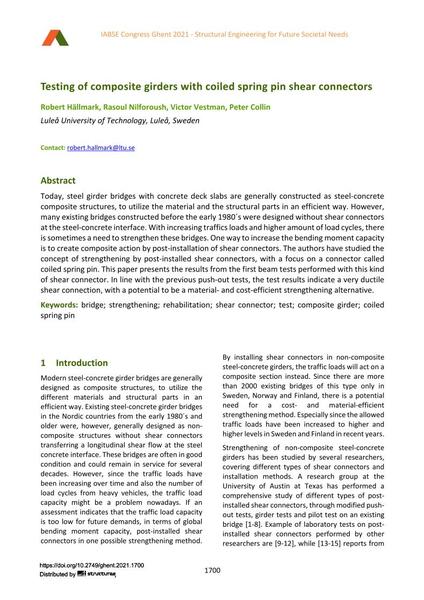Testing of composite girders with coiled spring pin shear connectors

|
|
|||||||||||
Bibliografische Angaben
| Autor(en): |
Robert Hällmark
Rasoul Nilforoush (Luleå University of Technology, Luleå, Sweden) Victor Vestman (Luleå University of Technology, Luleå, Sweden) Peter Collin (Luleå University of Technology, Luleå, Sweden) |
||||
|---|---|---|---|---|---|
| Medium: | Tagungsbeitrag | ||||
| Sprache(n): | Englisch | ||||
| Tagung: | IABSE Congress: Structural Engineering for Future Societal Needs, Ghent, Belgium, 22-24 September 2021 | ||||
| Veröffentlicht in: | IABSE Congress Ghent 2021 | ||||
|
|||||
| Seite(n): | 1700-1708 | ||||
| Anzahl der Seiten (im PDF): | 9 | ||||
| DOI: | 10.2749/ghent.2021.1700 | ||||
| Abstrakt: |
Today, steel girder bridges with concrete deck slabs are generally constructed as steel-concrete composite structures, to utilize the material and the structural parts in an efficient way. However, many existing bridges constructed before the early 1980´s were designed without shear connectors at the steel-concrete interface. With increasing traffics loads and higher amount of load cycles, there is sometimes a need to strengthen these bridges. One way to increase the bending moment capacity is to create composite action by post-installation of shear connectors. The authors have studied the concept of strengthening by post-installed shear connectors, with a focus on a connector called coiled spring pin. This paper presents the results from the first beam tests performed with this kind of shear connector. In line with the previous push-out tests, the test results indicate a very ductile shear connection, with a potential to be a material- and cost-efficient strengthening alternative. |
||||
| Stichwörter: |
Brücke Versuch Test Verstärkung Instandsetzung
|
||||
| Copyright: | © 2021 International Association for Bridge and Structural Engineering (IABSE) | ||||
| Lizenz: | Die Urheberrechte (Copyright) für dieses Werk sind rechtlich geschützt. Es darf nicht ohne die Zustimmung des Autors/der Autorin oder Rechteinhabers/-in weiter benutzt werden. |
||||
